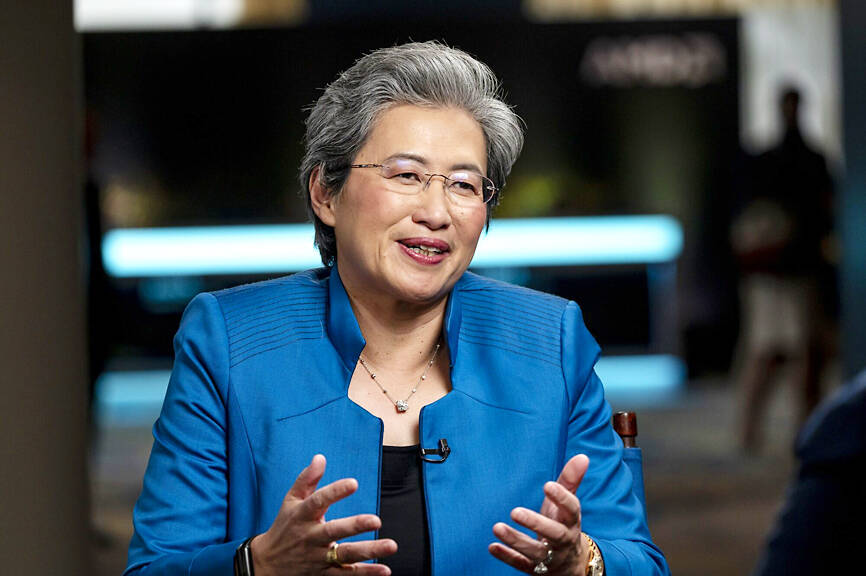Advanced Micro Devices Inc (AMD), taking aim at a burgeoning market dominated by Nvidia Corp, on Wednesday unveiled new accelerator chips that it said would be able to run artificial intelligence (AI) software faster than rival products.
The company introduced a long-anticipated lineup called the MI300 at an event in San Jose, California. AMD chief executive officer Lisa Su (蘇姿丰) also gave an eye-popping forecast for the size of the AI chip industry, saying it could climb to more than US$400 billion in the next four years.
That is more than twice as high as a projection AMD gave in August.

Photo: Bloomberg
Building AI systems that rival human intelligence — considered the holy grail of computing — is now within reach, Su said in an interview.
However, deployment of the technology is still only just beginning.
It would take time to assess the impact on productivity and other aspects of the economy, she said.
“The truth is we’re so early,” Su said. “This is not a fad. I believe it.”
AMD is showing increasing confidence that the MI300 lineup can win over some of the biggest names in technology, potentially diverting billions in spending toward the company.
Customers using the processors will include Microsoft Corp, Oracle Corp and Meta Platforms Inc, AMD said.
The new AMD chip has more than 150 billion transistors and 2.4 times as much memory as Nvidia’s H100, the current market leader, AMD said.
It also has 1.6 as much memory bandwidth, further boosting performance, it said.
Su said that the new chip is equal to Nvidia’s H100 in its ability to train AI software and much better at inference — the process of running that software once it is ready for real-world use.
While the company expressed confidence in its product’s performance, Su said it would not just be a competition between two companies. Many others will vie for market share, too.
At the same time, Nvidia is developing its own next-generation chips. The H100 is to be succeeded by the H200 in the first half of next year, giving access to a new high-speed type of memory. That should match at least some of what AMD is offering. And then Nvidia is expected to come out with a whole new architecture for the processor later in the year.

The US dollar was trading at NT$29.7 at 10am today on the Taipei Foreign Exchange, as the New Taiwan dollar gained NT$1.364 from the previous close last week. The NT dollar continued to rise today, after surging 3.07 percent on Friday. After opening at NT$30.91, the NT dollar gained more than NT$1 in just 15 minutes, briefly passing the NT$30 mark. Before the US Department of the Treasury's semi-annual currency report came out, expectations that the NT dollar would keep rising were already building. The NT dollar on Friday closed at NT$31.064, up by NT$0.953 — a 3.07 percent single-day gain. Today,

‘SHORT TERM’: The local currency would likely remain strong in the near term, driven by anticipated US trade pressure, capital inflows and expectations of a US Fed rate cut The US dollar is expected to fall below NT$30 in the near term, as traders anticipate increased pressure from Washington for Taiwan to allow the New Taiwan dollar to appreciate, Cathay United Bank (國泰世華銀行) chief economist Lin Chi-chao (林啟超) said. Following a sharp drop in the greenback against the NT dollar on Friday, Lin told the Central News Agency that the local currency is likely to remain strong in the short term, driven in part by market psychology surrounding anticipated US policy pressure. On Friday, the US dollar fell NT$0.953, or 3.07 percent, closing at NT$31.064 — its lowest level since Jan.

Hong Kong authorities ramped up sales of the local dollar as the greenback’s slide threatened the foreign-exchange peg. The Hong Kong Monetary Authority (HKMA) sold a record HK$60.5 billion (US$7.8 billion) of the city’s currency, according to an alert sent on its Bloomberg page yesterday in Asia, after it tested the upper end of its trading band. That added to the HK$56.1 billion of sales versus the greenback since Friday. The rapid intervention signals efforts from the city’s authorities to limit the local currency’s moves within its HK$7.75 to HK$7.85 per US dollar trading band. Heavy sales of the local dollar by

The Financial Supervisory Commission (FSC) yesterday met with some of the nation’s largest insurance companies as a skyrocketing New Taiwan dollar piles pressure on their hundreds of billions of dollars in US bond investments. The commission has asked some life insurance firms, among the biggest Asian holders of US debt, to discuss how the rapidly strengthening NT dollar has impacted their operations, people familiar with the matter said. The meeting took place as the NT dollar jumped as much as 5 percent yesterday, its biggest intraday gain in more than three decades. The local currency surged as exporters rushed to